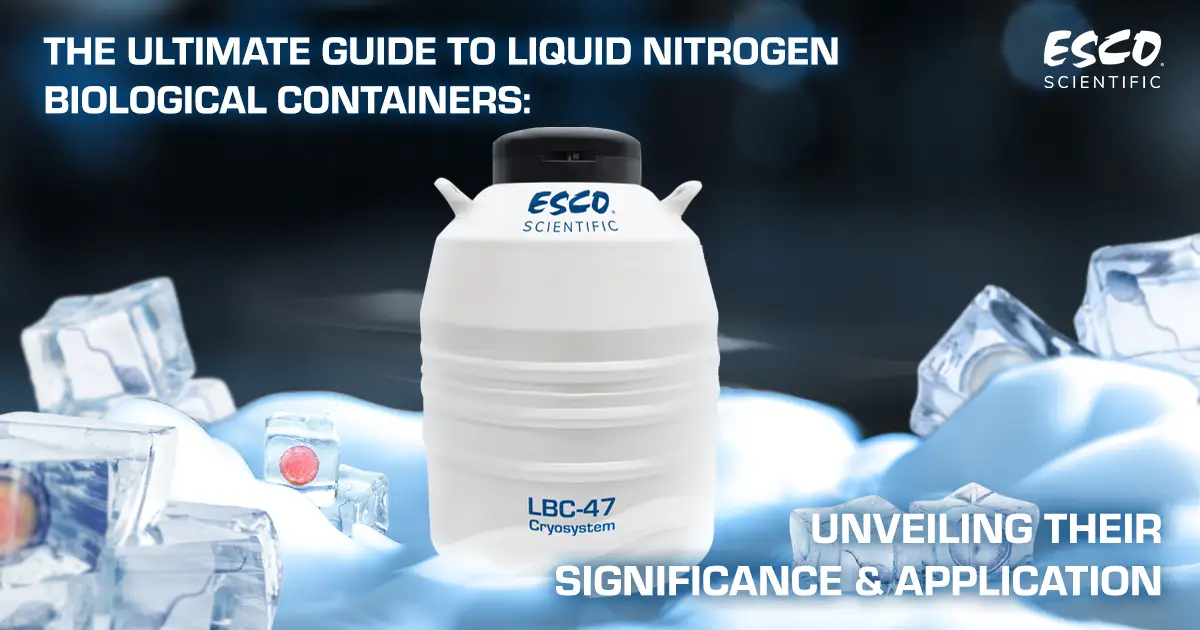
The Ultimate Guide to Liquid Nitrogen Biological Containers: Unveiling Their Significance and Application
Introduction
Liquid Nitrogen Biological Containers (LBCs) are used in various fields to preserve valuable biological materials. These containers provide a cryogenic environment essential for the long-term storage of sensitive biological samples such as cells, tissues, and other genetic materials. The ultra-cold temperature effectively halts all biological activity and degradation. Each metabolism and enzymatic reaction are frozen, which protects the cells, tissue, vaccines, drugs, semen, and embryos. Through insulation technology and advanced safety features, these containers ensure the stability and integrity of stored samples, making them crucial in fields like medical research, biobanking, and reproductive technology.
What is a Liquid Nitrogen Container and how does it work?
LBCs provide a suitable environment for long-term cryopreservation storage of biological specimens such as cells, tissues, DNA, sperm, eggs, embryos, and other samples at ultra-low temperatures. This ultra-low temperature is needed in cryopreservation to enable researchers and clinicians to store important specimens for future usage, making it suitable for pharmaceutical manufacturing among many other applications.
Biological specimens require a definite temperature before entering the LBCs. To achieve the appropriate temperature before being put in LBC, the cell will be stored in the freezer until it reaches -20 degrees, then moved to the ULT freezer until it reaches -80 degrees (the appropriate temperature). If the cell has reached the proper temperature, it is ready to be transferred to the LBCs, and biological specimens can be stored for an indefinite period.
As cryopreservation technology continues to develop, the applications of LBCs further expand to more fields in the global scientific community as well, including biobank facilities, medical and health research facilities, pharmaceutical industries, and livestock industries. Cryopreservation continues to advance biomedical research, develop medical treatments, and support scientific research.
Understanding Liquid Nitrogen
Liquid nitrogen is non-toxic, odorless, colorless, tasteless, inert, and non-flammable. The odorless gas can displace oxygen, and oxygen levels can drop when leaked into the air. It can cause severe damage to the skin and internal organs if mishandled or ingested by humans. Inhaling the vapor may also cause breathing difficulty, especially among individuals with asthma.
While liquid nitrogen is non-toxic, it can still cause severe damage like frostbite. To ensure user safety and effectiveness, operators must be knowledgeable about the characteristics of liquid nitrogen and comply with safety precautions when using LBCs.
How to Safely Handle Liquid Nitrogen?
Researchers or operators should observe proper safety precautions to mitigate the risks of liquid nitrogen usage:
- Do not directly touch or consume liquid nitrogen.
- Use Personal Protective Equipment (PPE) such as gloves, safety goggles, and lab coats.
- Work in a ventilated area to prevent the buildup of gas and minimize the risk of asphyxiation.
How do We Design Our Products?
Liquid Nitrogen Biological containers manufactured by Esco Lifesciences provide durable, lightweight, and efficient storage solutions for valuable biological samples. For the LBC lid, Esco has equipped the LBC with a unique self-locking mechanism featuring a locking buckle to prevent accidental opening. Esco also designed the container in eight models, available in various volume capacities, and features longer handles with high-strength fiberglass-reinforced plastic construction and convenient sample access. Esco provides high-grade aluminum, stainless steel, and high-strength plastic or polymer materials for the inner vessels to keep the biological samples safe at minimum temperature and multiple layers of insulation that incorporate aluminum foil with durability and resistance to corrosion. The space between the outer and inner shells is in a high vacuum state and the neck tube is fabricated from fiberglass to prevent thermal convection.
With a focus on quality, performance, and user safety, Esco Liquid Bio Containers are reputable among researchers and clinicians globally for their performance in preserving biological samples at ultra-low temperatures.
Advanced Liquid Nitrogen Container Features
Esco minimizes fluid consumption by developing superior heat insulation technology that reduces evaporation rates, uniformed multi-layer heat insulation with low thermal conductivity, and aluminum foil with excellent reflective performance. Integrated features such as secure sealing, leakproof design, and a safety locking cover secure sample safekeeping, deter unauthorized access, and mitigate the risk of accidental openings, ultimately safeguarding valuable samples and preventing potential accidents.
With these integrated advancements, Esco LBCs are reliable, efficient, and user-friendly cryogenic storage solutions, enabling advancements in various fields such as biotechnology, health care, and research.
Cryopreservation's Role Across Various Fields
Cryopreservation halts all biological activity, allowing for long-term storage and stability of specimens which plays a pivotal role in various fields, such as:

|
Medicine and Healthcare Cryopreservation is used for transplantation, regenerative medicine, and research. Preserving stem cells is fundamental for research, which promises to treat many diseases in the long run. |

|
Biotechnology and Research In recent years, the efficiency of cryopreservation has been improved for experimentation, developing drugs, and bioprocessing using cryopreserved samples. |

|
Agriculture Cryopreservation is essential for preventing many species from vanishing. By preserving its seeds, pollen, and plant tissues, it maintains genetic diversity, protects plants from diseases and environmental challenges, and supports breeding programs. |

|
Veterinary Science Researchers prevent disease and extinction in various species by preserving the genetic material of endangered animal species, valuable live stocks, and companion animals with artificial insemination, embryo companionship, and conservation efforts. |

|
Assisted Reproductive Technologies (ART) Enable individuals to preserve fertility in vitro fertilization (IVF). Cryopreservation can keep sperm eggs, embryos, and ovarian tissue in reproductive biology research. |

|
Biobanking and Forensic Applications Enabling the storage of biological samples such as DNA, tissues, and fluids for research, diagnostics, and forensic investigations for population studies and medical research. |

|
Food Industry Cryopreservation can maintain the quality, texture, and nutritional value of food by freezing it rapidly, thereby preserving food products, including seafood, fruits, and vegetables. |
Read more about Esco Liquid Nitrogen Biological Container: Working Safely with Liquid Nitrogen Biological Container
Citation:
- What is liquid nitrogen and when is it deadly? (nbcnews.com)
- Liquid Nitrogen and Dry Ice in the Food Code (fda.gov)
- Liquid Nitrogen Facts, Safety and Uses (thoughtco.com)
- How Cryogenic Storage Works with Liquid and Vapor Nitrogen (biolifesolutions.com)
- liquid-nitrogen-storage_fact-sheet.pdf (utah.edu)
- Cryopreservation to Improve Cell Manufacturing and Biobanking (genengnews.com)
- Introductory Chapter: Application Fields of Cryopreservation Biotechnology | IntechOpen
